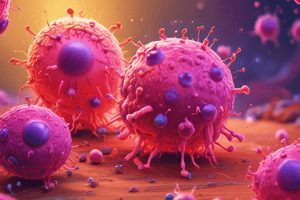Podcast
Questions and Answers
What is the basis for the multiple serotypes of Neisseria gonorrhoeae?
What is the basis for the multiple serotypes of Neisseria gonorrhoeae?
- Difference in protein I and protein II
- Presence of a polysaccharide capsule
- Variation in outer membrane protein III
- Antigenicity of its pilus protein (correct)
What is the function of Protein II in Neisseria gonorrhoeae?
What is the function of Protein II in Neisseria gonorrhoeae?
- Production of the polysaccharide capsule
- Attachment of the organism to cells (correct)
- Variation in antigenicity
- Regulation of chromosomal rearrangement
How many serotypes of Neisseria gonorrhoeae are known?
How many serotypes of Neisseria gonorrhoeae are known?
- Less than 10
- Over 50
- More than 100 (correct)
- Only 1
What is responsible for the antigenic variation in the gonococcal pili?
What is responsible for the antigenic variation in the gonococcal pili?
Which of the following is NOT a characteristic of Neisseria gonorrhoeae?
Which of the following is NOT a characteristic of Neisseria gonorrhoeae?
Study Notes
Neisseria Gonorrhoeae (Gonococcus)
- Lacks a polysaccharide capsule
- Has multiple serotypes based on the antigenicity of its pilus protein
- Antigenic variation in gonococcal pili occurs due to chromosomal rearrangement
- There are over 100 known serotypes
- Has three outer membrane proteins: proteins I, II, and III
- Protein II plays a role in attachment of the organism to cells
- Protein II varies antigenically
Studying That Suits You
Use AI to generate personalized quizzes and flashcards to suit your learning preferences.
Description
This quiz covers the characteristics of Neisseria gonorrhoeae, including its pilus protein, outer membrane proteins, and antigenic variation. Learn about the structure and properties of this bacterium.




